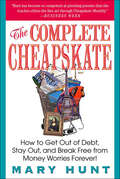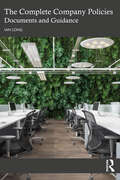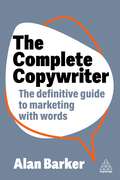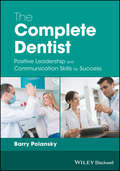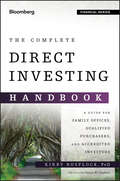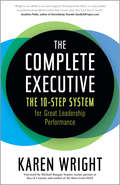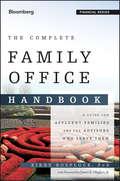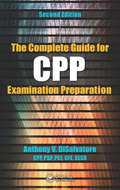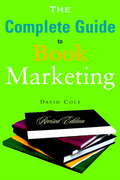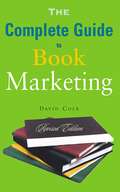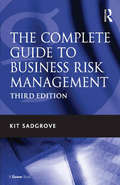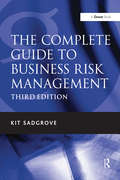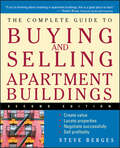- Table View
- List View
The Complete Caterer Revised: A Practical Guide to The Craft and Business of Catering
by Elizabeth LawrenceHere is the complete guide for the rookie caterer, thoroughly revised and updated and now available in paperback. Lawrence gives readers everything they need to start a successful catering business, explaining how to price and market one's services and deal with insurance, taxes, and the law.
The Complete Cheapskate: How to Get Out of Debt, Stay Out, and Break Free from Money Worries Forever
by Mary HuntIn need of a Money Makeover? Let America's most popular cheapskate show you how to go from financial chaos to freedom and security--painlessly and in less time than you ever imagined. Mary Hunt has helped thousands live a debt-free life with her popular newsletter, "The Cheapskate Monthly." In The Complete Cheapskate, Mary puts all the very best money advice she has in one place. Becoming a classy, dignified cheapskate is not all that difficult, and Mary shows how with her user-friendly principles of saving, restraint, and living debt-free. This book will teach you how to: - Create--and stick to--a monthly spending plan - Live well off 80% of your income - Climb out--and stay out--of debt's hole - Stretch every dollar to its absolute maximum - Manage savings and investments - Lower bills on clothes, food, and gifts without lowering living standards - Live within a financial plan that includes a margin for fun and spontaneityWith hundreds of tips on cutting expenses, The Complete Cheapskate is the indispensable guide for people ready to regain control of their finances, relieve the stress money has created, and prepare for their future.
The Complete Company Policies: Documents and Guidance
by Ian LongThis book is about a much neglected but essential element of the success of any business: company policy. This is a comprehensive guide to determining what policies your company needs, and how to draft and approve the relevant documents and implement them throughout the organization. From anti-bribery laws to data privacy and health and safety, your business is faced with a range of legal and regulatory obligations that must be identified and documented properly. These obligations must be addressed for internal and external stakeholders. The task of identifying and documenting effective policies is an essential step in establishing good corporate governance and ultimately a culture of compliance. These policies in turn provide a solid foundation for the reputation and commercial success of the organization, and form an essential "bridge" between the company’s strategy and the various procedures needed to carry it out. With many useful templates and practical examples, this book will help you to ensure the accuracy and completeness of your policy documents. It covers all areas of your business, including financial reporting, anti-money laundering, anti-fraud, conflicts of interest, data privacy and security, remote working, social media, whistleblowing, and more.This book will be useful to company directors, company secretaries and senior managers, and their advisers, including consultants, auditors, and solicitors. It will be particularly relevant to any business that needs to create or review their policies in light of current regulations and standards.
The Complete Copywriter: The Definitive Guide to Marketing with Words
by Alan BarkerWriting good copy is no longer just about advertising or selling or direct mail. You need to develop a deep understanding of your customers and use your imagination to create and curate content that resonates with them. As marketing becomes more multi-platformed, more measurable and enabled by digital tools and regenerative-AI, marketing communications must be increasingly nuanced, responsive and with a distinct human touch. From paid social to press releases, from landing pages to white papers and from internal communications to engaging with customers, the sheer range of writing challenges can feel daunting. How can you keep it targeted? How can you keep it personal? How can you keep it conversational? The Complete Copywriter gives you all the tools you'll need to create exceptional marketing copy. This comprehensive guide covers every aspect of the copywriting craft, from creativity and planning, to revision and execution. Learn how to exercise your creativity, be refreshingly adaptable with your words, generate ideas, maintain reader attention, hone your empathy and bring words to life, so that you deliver copy that works every time.
The Complete Dentist: Positive Leadership And Communication Skills For Success
by Barry PolanskyThe Complete Dentist: Positive Leadership and Communication Skills for Success is a one-of-a-kind guide to starting and running an effective and successful dental practice. Presents tried-and-true ideas and methods for effective communication, blending positive psychology with leadership in dentistry Describes the five elements of success and happiness, offering pathways to a flourishing dental practice Considers the reasons why communication and leadership skills are important for dentists
The Complete Direct Investing Handbook: A Guide for Family Offices, Qualified Purchasers, and Accredited Investors
by Kirby RosplockThe practical guide to direct investing strategies and best practices The Complete Direct Investing Handbook provides comprehensive guidelines, principles and practical perspectives on this increasingly attractive private equity investment strategy. Interviews with leading family office investors, qualified private equity buyers, and top direct investing advisors provide essential insights, and attention to the nuanced processes of direct investing. The books is a hands-on resource for family offices and those investors interested in generating returns through private company ownership to be more effective in creating returns in a complex market. Direct investing best practices are explored in-depth, with guidance on strategy and the evaluation and assessment of various investment opportunities. The process begins with a codified and specific investment goal, and a robust strategy tailored to the investor's individual needs. Useful insight on 'narrowing the field' helps investors select the appropriate opportunities to meet their investment goals, and practical tools help streamline the process of capital deployment and in turn providing more opportunities to achieve desired returns. Despite the growing interest in direct investing, there is little public information available to investors and there is a lack of transparency into practical standards. This book bridges the gap between strategy and execution, with comprehensive guidance and real-world insights. Define and craft a focused investment thesis and appropriate timeline specific to your needs Identify the right type, size, duration, and risk profile aligned to your investment objectives Gain perspective on real-world direct investing and a deeper understanding of the risks and rewards Better understand best practices and institutional investment rigor to develop bespoke processes and policies that create better outcomes for independent investors Historically, extraordinary wealth has been created through equity in privately-held enterprise. Today, family offices and direct investors are looking more and more toward large capital deployment in early-stage and growth-oriented private equity investments, but are constrained by a lack of informed, established practices. The Complete Direct Investing Handbook provides the much-needed guidance and tools that can improve direct investment outcomes.
The Complete Engineering Manager: Build High-Performing Engineering Teams for Your Organization
by Ananth RamachandranTake a 360-degree tour of the engineering manager’s role and responsibilities. This book brings them to life with practical scenarios and references and ensures their relevance to your daily work. From upkeeping technical skills, to managing people and stakeholders, to ensuring timely deliverables, the job of the engineering manager is fast-paced, complex, and often short on learning resources. Fear not, this book has you covered with tips on managing evolving processes, delivering impactful projects in a timely manner, setting goals and priorities among product and technical initiatives, and helping your team focus and deliver. Business priorities are changing at a much faster pace than ever before with new technologies being introduced and adopted regularly. This book will help managers adopt modern practices to meet this moment and aid them in helping engineering teams succeed. The Complete Engineering Manager will leave you with a broader perspective and deeper skill set to apply to engineering management. What You Will Learn Employ the SELF framework for self-management and learn to build trust with team members Manage performance and craft individualized growth plans for employee success Evolve your team’s development, delivery, and technical processes to improve their efficiency Drive impact for your organization through prioritization, strategy and value delivery Build a high-performing engineering team with a strong and positive culture Who This Book is For New, aspiring, and experienced engineering managers who are looking for resources to address challenges in their role.
The Complete Executive: The 10-Step System for Great Leadership Performance
by Karen WrightBeing a leader requires much more than just understanding how to run a business. Today's executive is under an extraordinary set of demands, coming from multiple stakeholders and as such requires an extraordinary set of habits, practices, and disciplines in order to be able to not only succeed, but thrive, at the top. In The Complete Executive, long-time executive coach Karen Wright introduces a unique 10-step system that takes all of these aspects of leadership development into account. Leaders not only need incredible physical energy and stamina, they need a support system, a philosophy, a plan, business acumen, a social network, and a brand and reputation that will ensure they achieve their vision. Backed by an assessment tool, giving each leader a personal "report card," this book provides aspiring leaders with a framework to address all aspects of leadership that translates to peak performance. Wright knows from experience that even when everything is going well for leaders, high achievers don't stop there, which is why The Complete Executive is designed as a resource to return to again and again for continuous improvement.
The Complete Family Office Handbook
by Kirby RosplockEverything you need to know for successful wealth management for families Although the family office concept is not new, it is a phenomenon that is changing the wealth management landscape. With celebrities and business moguls, investment gurus and family business icons establishing private wealth management advisory firms, more and more individuals are asking what exactly is a family office and how does it operate? Family offices either serve one family exclusively or typically manage the wealth of a number of affluent families. If you're like most families and advisors, you're familiar with family offices, but may not know exactly how they work or why the family office is right for you or your clients. Dr. Kirby Rosplock, an expert on the family office concept, provides insights to some of the most common questions and even misperceptions in this handbook. The Complete Family Office Handbook explains how family offices operate, who should consider forming or joining one, and how to craft and set up a structure, purpose and vision for the office that fully serves a family's particular needs and investment goals. Whether you're a wealth creator, a member of a wealthy family considering forming or joining a family office, or a professional contemplating a career in this growing segment of the wealth management industry, this comprehensive guide provides insights to some of the most common questions and misperceptions.
The Complete Family Office Handbook: A Guide for Affluent Families and the Advisors Who Serve Them (Bloomberg Financial Ser.)
by Kirby RosplockDiscover new insights on how to setup, manage, and advise wealthy families and their family offices The Complete Family Office: A Guide for Affluent Families and the Advisors Who Serve Them, 2nd Edition represents the newest update to an essential series. This book prepares the members of wealthy families to collectively manage, sustain, and grow their wealth across multiple generations. It also assists professionals who advise families to better serve their needs. This book teaches those who advise family offices and wealthy families on: · How to setup, structure, and advise a family office · Current compliance, fiduciary and risk management practices for a family office · Forward-thinking investment management, estate planning, and private trust company considerations · Fresh insights on philanthropy, legacy, and impact investing · Best practices to managing family wealth education and preparing next generation owners · New insights on family governance, strategic planning, and succession · Methods to create a family constitution, mission, and vision for families and their family offices. The Complete Family Office Handbook provides the most comprehensive, current research, practical guidance, and approaches from leading family offices from around the globe and illustrates, by way of practical case studies and examples, how families can effectively manage their wealth for the long term.
The Complete Guide To Credit Repair
by Bill KellyWith more and more people declaring bankruptcy and total debt in this country rising, the time is perfect for a book like The Complete Guide to Credit Repair. Not only will this book show people how to repair bad credit to stay out of bankruptcy, it will show them how to avoid bad credit in the future and what they can do to strengthen their situation.Credit bureau information and other vital resources have all changed within the last few years. The Complete Guide to Credit Repair - written in a simple, straightforward tone - is packed with up-to-date information on a topic that millions of people face everyday.
The Complete Guide To Personal Finance: For Teenagers and College Students
by Tamsen ButlerIn this book, you will learn how to get and manage credit, how to make and stick to a budget, how to save for college, how to determine your needs versus your wants, how to pay for a car, how to finance college, how to manage risk, how to open a bank account, how to write a check, how to balance a checkbook, how to avoid the pressures of consumerism, and how to avoid financial mistakes. You will also learn about investment options, taxes, checks, debit cards, credit cards, and basic budget tips. This book is filled with helpful suggestions from financial and family counselors, and you will discover creative ways to get a jumpstart on your financial future and use money responsibly. Even if you have had a few missteps along the way, you will be able to learn from your mistakes and get on the path to financial well-being.
The Complete Guide To Sarbanes-Oxley
by Stephen M. BainbridgeAs of the end of 2006, small businesses, which were once exempt, now have to comply with Sarbanes-Oxley (SOX). Under Sarbanes-Oxley, they will now be exposed to audits, reviews and will have to make their profits, losses, and compensation packages public.The Complete Guide to Sarbanes-Oxley will answer the following questions:How do companies comply with SOX?How does SOX effect relations within the firm?Should a public company go private to avoid SOX?The Complete Guide to Sarbanes-Oxley is a nontechnical, "plain English" guide for the managers and directors of the 13,000 publicly held corporations now subject to SOX. No business owner should be without it!
The Complete Guide To Sarbanes-Oxley: Understanding How Sarbanes-Oxley Affects Your Business
by Stephen M BainbridgeAs of the end of 2006, small businesses, which were once exempt, now have to comply with Sarbanes-Oxley (SOX). Under Sarbanes-Oxley, they will now be exposed to audits, reviews and will have to make their profits, losses, and compensation packages public.The Complete Guide to Sarbanes-Oxley will answer the following questions:How do companies comply with SOX?How does SOX effect relations within the firm?Should a public company go private to avoid SOX?The Complete Guide to Sarbanes-Oxley is a nontechnical, "plain English" guide for the managers and directors of the 13,000 publicly held corporations now subject to SOX. No business owner should be without it!
The Complete Guide for CPP Examination Preparation
by Anthony V. DiSalvatore (CPP PSP & PCI)Originally written by a team of Certified Protection Professionals (CPPs), Anthony DiSalvatore gives valuable updates to The Complete Guide for CPP Examination Preparation. This new edition contains an overview of the fundamental concepts and practices of security management while offering important insights into the CPP exam.Until recently the sec
The Complete Guide to Book Marketing
by David ColeCole, a longtime marketing consultant and previously marketing director of Nolo Press, explains why this is, and what authors, publishers, and self-publishers can do to make works stand out in the crowded marketplace. The revised edition includes low-risk strategies for book marketing in a tight economy (such as marketing reprints and backlist titles), discusses strategies for breaking into the education market, and looks at e-book marketing and print-on-demand.
The Complete Guide to Book Marketing
by David ColeWith an intense focus on strategy that won't be found in any other guide, this invaluable resource will be of immediate help to publishers, authors, and most anyone who wants to succeed in the publishing industry.Completely updated and expanded with an enhanced focus on selling outside traditional channels, The Complete Guide to Book Marketing features systematic, results-oriented approaches to reaching the largest amount of readers for the least amount of money. Readers will find no-nonsense advice for building a publishing identity, cultivating feedback from your audience, and implementing an effective publicity campaign. This new edition also features a brand-new section on marketing to the lucrative education market, as well as new information on e-book marketing, print-on-demand, and marketing backlist and reprint titles.
The Complete Guide to Book Publicity: Second Edition
by Jodee BlancoWritten by one of the country's leading publicists, this is an authoritative, in-depth guide to the unique form of publicity needed to successfully launch a book. Step by step, readers are coached through the stages of a book's publicity lifecycle. The nuts and bolts of book promotion are covered for fiction, nonfiction, hardcover trade, mass market, and trade paperbacks. A thorough "publicity toolbox" of sample press kits.
The Complete Guide to Business Risk Management
by Kit SadgroveRisk management and contingency planning has really come to the fore since the first edition of this book was originally published. Computer failure, fire, fraud, robbery, accident, environmental damage, new regulations - business is constantly under threat. But how do you determine which are the most important dangers for your business? What can you do to lessen the chances of their happening - and minimize the impact if they do happen? In this comprehensive volume Kit Sadgrove shows how you can identify - and control - the relevant threats and ensure that your company will survive. He begins by asking 'What is risk?', 'How do we assess it?' and 'How can it be managed?' He goes on to examine in detail the key danger areas including finance, product quality, health and safety, security and the environment. With case studies, self-assessment exercises and checklists, each chapter looks systematically at what is involved and enables you to draw up action plans that could, for example, provide a defence in law or reduce your insurance premium. The new edition reflects the changes in the global environment, the new risks that have emerged and the effect of macroeconomic factors on business profitability and success. The author has also included a set of case studies to illustrate his ideas in practice.
The Complete Guide to Business Risk Management
by Kit SadgroveRisk management and contingency planning has really come to the fore since the first edition of this book was originally published. Computer failure, fire, fraud, robbery, accident, environmental damage, new regulations - business is constantly under threat. But how do you determine which are the most important dangers for your business? What can you do to lessen the chances of their happening - and minimize the impact if they do happen? In this comprehensive volume Kit Sadgrove shows how you can identify - and control - the relevant threats and ensure that your company will survive. He begins by asking 'What is risk?', 'How do we assess it?' and 'How can it be managed?' He goes on to examine in detail the key danger areas including finance, product quality, health and safety, security and the environment. With case studies, self-assessment exercises and checklists, each chapter looks systematically at what is involved and enables you to draw up action plans that could, for example, provide a defence in law or reduce your insurance premium. The new edition reflects the changes in the global environment, the new risks that have emerged and the effect of macroeconomic factors on business profitability and success. The author has also included a set of case studies to illustrate his ideas in practice.
The Complete Guide to Buying and Owning a Recreational Property in Canada
by Douglas GrayPrime vacation property throughout Canada has doubled in value within the past five years. For the potential buyer of a vacation property, the cost of entry can be stiff. There is a high demand for many to own a vacation home or idyllic retreat for pleasure and lifestyle enjoyment, future retirement, rental revenue, or investment profit. But buying a recreational property can be a potential minefield for many reasons, as there can be complex tax, legal, estate planning, and investment issues to consider. When investing hundreds of thousands of dollars in a recreational property you will need to do your due diligence and seek solid advice. The Complete Guide to Buying and Owning Recreational Property in Canada, written by Canada's leading authority on matters related to real estate, offers valuable insights and tips, and will prove a trustworthy resource for many years to come. Topic areas include: Buying the right property, for the right reasons, in the right location How to set a purchase and financing strategy and how to negotiate your best deal How to exercise caution when buying with family or friends-and how to keep peace in the family when sharing use or ownership Getting the help of professionals, such as a tax accountant, lawyer, home inspector, mortgage broker, insurance broker, and realtor. Obtaining tax and estate planning strategic advice to save tax on transfer, sale or bequeathing of the property, or inheriting a property What you need to know if you are buying recreational property as an investment. Money saving tips when renting your property yourself or using professional rental management Special cautions if buying a vacation home or cottage outside of Canada Creative ways of using your vacation home or cottage for exchange or barter Key strategies to follow and classic pitfalls to avoid And much, much more! Plus Sources of Further Information, Key Websites, Checklists, Glossary, and Index.
The Complete Guide to Buying and Selling Apartment Buildings
by Steve Berges&“Berges shares a framework investors can use to make the transition from buying single-family homes to successfully investing in multifamily properties.&” —The Real Estate CPA, &“18 of the Best Books on Real Estate Investing&” Whether you&’re a first-time real estate investor or a seasoned professional, The Complete Guide to Buying and Selling Apartment Buildings helps you map out your future, find apartment buildings at a fair price, finance purchases, and manage your properties. Now revised and expanded, this Second Edition includes tax planning advice, case studies of real acquisitions, and appendixes that add detail to the big picture. Plus, it includes a handy glossary of all the terms investors need to know, helpful sample forms that make paperwork quick and easy, and updated real estate forecasts. With this comprehensive guide at hand you&’ll find profits easy to come by. &“If you&’re thinking about investing in apartment buildings, this is a good place to start.&” —Robert Bruss, nationally syndicated columnist
The Complete Guide to Conflict Resolution in the Workplace
by Marick F. Masters Robert R. AlbrightPeople thrive on conflict in most areas of their lives--football games, political debates, legal disputes--yet steer clear from workplace conflicts. However, conflict is a healthy way to challenge the existing order and essential to change in the workplace. The real problem is not conflict per se, but managing conflict.
The Complete Guide to Credit Repair
by Bill Kelly<p>With more and more people declaring bankruptcy and total debt in this country rising, the time is perfect for a book like <i>The Complete Guide to Credit Repair</i>. Not only will this book show people how to repair bad credit to stay out of bankruptcy, it will show them how to avoid bad credit in the future and what they can do to strengthen their situation. <p>Credit bureau information and other vital resources have all changed within the last few years. <i>The Complete Guide to Credit Repair</i> - written in a simple, straightforward tone - is packed with up-to-date information on a topic that millions of people face everyday.</p>
The Complete Guide to Credit Repair
by Bill Kelly Jr.The Complete Guide to Credit Repair written in a simple, straightforward tone is packed with up-to-date information on a topic that millions of people face everyday.

